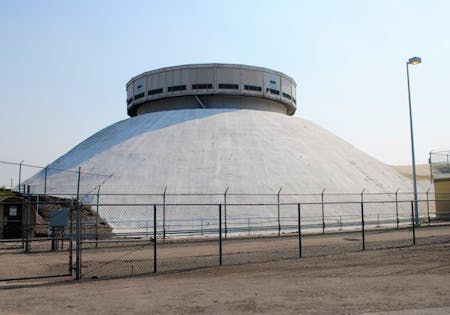The former Zero-Power Physics Reactor cell at INL’s Materials and Fuels Center could be home to the MCRE. (Photo: INL)
The Vallecitos Nuclear Center in northern California. (Photo: Wikimedia Commons)
GE Hitachi Nuclear Energy announced May 9 that it intends to transfer ownership of the 1,600-acre GEH Vallecitos Nuclear Center to NorthStar Group Services for nuclear decontamination, decommissioning, and environmental site restoration.
Hanford’s Waste Treatment and Immobilization Plant, also known as the Vit Plant. (Photo: Bechtel National)
The Department of Energy’s Office of Environmental Management awarded a 10-year contract worth up to $45 billion to Hanford Tank Waste Operations and Closure (H2C) of Lynchburg, Va., to oversee the management of liquid radioactive tank waste at the DOE’s Hanford Site in southeastern Washington state.
A loaded MP197HB cask is prepared for departure from the Vermont Yankee decommissioning site to West Texas. (Photos: Orano TN)
The rapid changes in the nuclear energy industry over the last decade, driven in part by fluctuating energy market prices and an aging fleet of reactors, have led to the closure of multiple reactors in the United States and other countries. These closures have increased the need for larger and more efficient ways to manage low-level radioactive waste processing and transport capacities. The safe transport of radioactive material is a key component of the overall nuclear industry reliability. Though sometimes perceived as a bottleneck and costly, it is necessary to send waste material to disposal.
A rendering of the MCRE. (Image: Southern Company)
The Gateway for Accelerated Innovation in Nuclear (GAIN) awarded vouchers to Orano Federal Services and TerraPower on June 22, giving them access to specialized facilities and expertise at Department of Energy national laboratories. Orano is partnering with Oak Ridge National Laboratory on a new technical study that updates the physical chemistry limits for the safe transport of uranium hexafluoride (UF6) gas enriched up to 10 percent in existing shipping containers, and TerraPower is turning to Los Alamos National Laboratory’s neutron testing capabilities to measure the properties of chlorine isotopes and determine how they will behave in the Molten Chloride Reactor Experiment (MCRE).
SeAH Besteel’s Gusan plant in South Korea. (Image: SeAH Besteel)
Orano TN Americas and South Korean special steel maker SeAH Besteel last week announced the completion and delivery of the first dual-purpose used nuclear fuel dry storage cask manufactured for a U.S. utility by the Korean company.
Following Orano’s purchase order in September 2019, SeAH Besteel established a mass production system for Orano’s dual-purpose casks in compliance with U.S. and international nuclear standards. Orano TN Americas is a subsidiary of France’s Orano NPS.
The Molten Chloride Reactor Experiment will be built at Idaho National Laboratory to demonstrate criticality in a fast-spectrum salt-cooled reactor within five years. (Image: Southern Company)
Click to open full graphic
The Nuclear Regulatory Commission has issued a license to Interim Storage Partners (ISP), a joint venture of Waste Control Specialists and Orano USA, to construct and operate a consolidated interim storage facility for spent nuclear fuel in Andrews, Texas. Issued on September 13, the license comes just four days after Texas governor Greg Abbott signed a bill to block such a facility from being built in the state.
A ceremony marking the delivery of Orano’s TN-LC transport cask to Korea Hydro and Nuclear Power Company was held on August 24. (Photo: Orano)
Orano has delivered its first TN-LC spent nuclear fuel transport cask to Korea Hydro and Nuclear Power Company. The first use of the cask is planned for an international transport between South Korea and Sweden by the end of 2021.
KHNP received a license in June for the TN-LC transport cask from the Nuclear Safety and Security Commission, South Korea’s regulatory agency, for the transport of high-burnup spent fuel.
Miners depart Niger’s Akouta uranium mine for the last time after production ended for good. Photo: Cominak
The Akouta mine in Niger stopped production on March 31 after 43 years of service and 75,000 metric tons of uranium extracted. Akouta, the largest underground uranium mine in the world, was operated by Cominak, a subsidiary of Orano. The shutdown was decided by Cominak’s board of directors on October 23, 2019, in response to the depletion of the mine’s deposit.

















